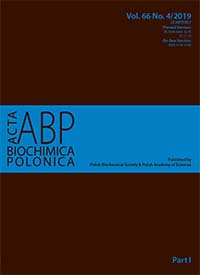Is the mechanism of nitroglycerin tolerance associated with aldehyde dehydrogenase activity? A contribution to the ongoing discussion
Abstract
The aim of the study presented here was an attempt to answer the question posed in the title: Is the mechanism of nitroglycerin tolerance associated with aldehyde dehydrogenase (ALDH) activity? Here, we investigated the effect of administration (separately or jointly) of lipoic acid (LA), nitroglycerin (GTN), and disulfiram (DSF; an irreversible in vivo inhibitor of all ALDH isozymes (including ALDH2)), on the development of tolerance to GTN. We also assessed the total activity of ALDH in the rat liver homogenates. Our data revealed that not only DSF and GTN inhibited the total ALDH activity in the rat liver, but LA also proved to be an inhibitor of this enzyme. At the same time, the obtained results demonstrated that the GTN tolerance did not develop in GTN, DSF and LA jointly treated rats, but did develop in GTN and DSF jointly treated rats. This means that the ability of LA to prevent GTN tolerance is not associated with the total ALDH activity in the rat liver. In this context, the fact that animals jointly receiving GTN and DSF developed tolerance to GTN, and in animals that in addition to GTN and DSF also received LA such tolerance did not develop, is – in our opinion – a sufficient premise to conclude that the nitrate tolerance certainly is not caused by a decrease in the activity of any of the ALDH isoenzymes present in the rat liver, including ALDH2. However, many questions still await an answer, including the basic one: What is the mechanism of tolerance to nitroglycerin?
Acta Biochimica Polonica is an OpenAccess quarterly and publishes four issues a year. All contents are distributed under the Creative Commons Attribution-ShareAlike 4.0 International (CC BY 4.0) license. Everybody may use the content following terms: Attribution — You must give appropriate credit, provide a link to the license, and indicate if changes were made. You may do so in any reasonable manner, but not in any way that suggests the licensor endorses you or your use.
Copyright for all published papers © stays with the authors.
Copyright for the journal: © Polish Biochemical Society.


